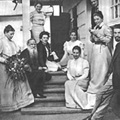Tolstoy and the "Woman Question"

What did Tolstoy truly think of the place of a woman in society? The author appears to endorse only two routes for a heroine's happiness in his major fiction: marriage and motherhood for Kitty, death and disfigurement for Anna. Yet, he still seemed to feel the sting of injustice. In his later essay, What, Then, Shall We Do?, and his Dickensian novel, Resurrection, Tolstoy successfully indicts a social order that creates impossible choices for women. Even in Anna Karenina, it's difficult not to feel the empathy he negotiates for all the characters' tough situations.
The Heart of the "Woman Question"At the time Tolstoy was drafting Anna Karenina, the pages of the Russian "thick journals"—where most novels appeared in serial form and most political debates were waged—were filled with discussion of the social questions urgently under consideration: the slavery question, the sexual question, and the "woman question." This last issue concerned the status and proper role of women in society, whether or not women should receive higher education, access to the professions, or the right to retain legal ownership of their children or property. The debates were stimulated by the publication in Russian of John Stuart and Harriet Mills' essays on the place of women in British society. In 19th century England, women outnumbered men 1.5 to 1, a factor which limited the chances of a young woman in marriage. The increasing number of spinsters who were unable to support themselves became the main topic of debate in both England and in Russia, as exemplified in the drawing room discussion following the Oblonskys' dinner party in Anna Karenina. Similarly, Russian bachelors began to postpone marriage due to social conditions, leaving many spinsters, like Kitty's friend Varenka, with no means of livelihood other than the charity of family or friends. Marriage was a woman's only possible escape from a life of dependency, poverty or prostitution, yet marriage itself could prove impermanent, resulting in a class of divorced women living on the margins of society; the position of a divorcee like Anna meant almost complete social isolation. Dolly's constant struggle to feed and clothe her children would have obviously become even more desperate if she had divorced her husband for infidelity.
Spinsters and Old Maids
Tolstoy was well aware of the impoverished lifestyle of the divorcee with children, as during the years he was writing Anna Karenina, he assisted his own sister in obtaining a divorce and setting up house by herself with her children. He also wrote with increasing compassion about dependent spinsters. Sonya, in War and Peace, is patterned after the maiden aunt who raised the Tolstoy boys after their mother's death. The character of Varenka, who serves as a role model for Kitty during her stint as an old maid, is the first in a series of valorous single women in Tolstoy's literature. Varenka, like Florence Nightingale, takes up the role of a nurse in order to craft a meaningful life for herself. In describing heroic women of the Florence Nightingale type, Tolstoy is comparable to many late Victorian authors (like novelists Thomas Hardy and George Gissing) who wrote of spinster heroines whose very names indicate their essentially chaste and non-sexual natures. These types of spinsters seem stereotypical in their dry natures, especially in contrast to what is perhaps Tolstoy's most evocative portrait of an old maid: Lady Mary, in War and Peace. Lady Mary is neither beautiful nor accomplished, and she experiences no call to social service, but rather, to the monastic life. Her family's failure to find her a husband and her own inability to attract a suitor seem to foretell a future as a spinster. Although she does marry and have children, she retains what feels like an "otherworldly nature," outside that of traditional motherhood.
Championing Motherhood
When Tolstoy was an old man, he discovered a pair of unknown woman's footprints in his garden. As he gazed at them, he recounts imagining an "ideal" woman that he envisions as his mother, who had died before he could form a memory of her. This passage in his diary is filled with pain and hopeless longing.
Did Tolstoy's lifelong yearning for his mother shape his view of women and of motherhood? In many respects, how could it not? We know that in his personal life, Tolstoy took a passionate interest in his wife's experience of maternity. Just before writing Anna Karenina, Tolstoy championed motherhood as the divinely ordained role for women in his written response to John Stuart Mill's essay "On the Subjection of Women." Lucky for Tolstoy, his lifelong fascination with women's sexuality and experiences of maternity coincided with the general social debates of his time. This was fertile ground. From his yearnings for a mother he never knew sprang portraits of women who haunt us and inform us even to this day.
When Tolstoy was an old man, he discovered a pair of unknown woman's footprints in his garden. As he gazed at them, he recounts imagining an "ideal" woman that he envisions as his mother, who had died before he could form a memory of her. This passage in his diary is filled with pain and hopeless longing.
Did Tolstoy's lifelong yearning for his mother shape his view of women and of motherhood? In many respects, how could it not? We know that in his personal life, Tolstoy took a passionate interest in his wife's experience of maternity. Just before writing Anna Karenina, Tolstoy championed motherhood as the divinely ordained role for women in his written response to John Stuart Mill's essay "On the Subjection of Women." Lucky for Tolstoy, his lifelong fascination with women's sexuality and experiences of maternity coincided with the general social debates of his time. This was fertile ground. From his yearnings for a mother he never knew sprang portraits of women who haunt us and inform us even to this day.



